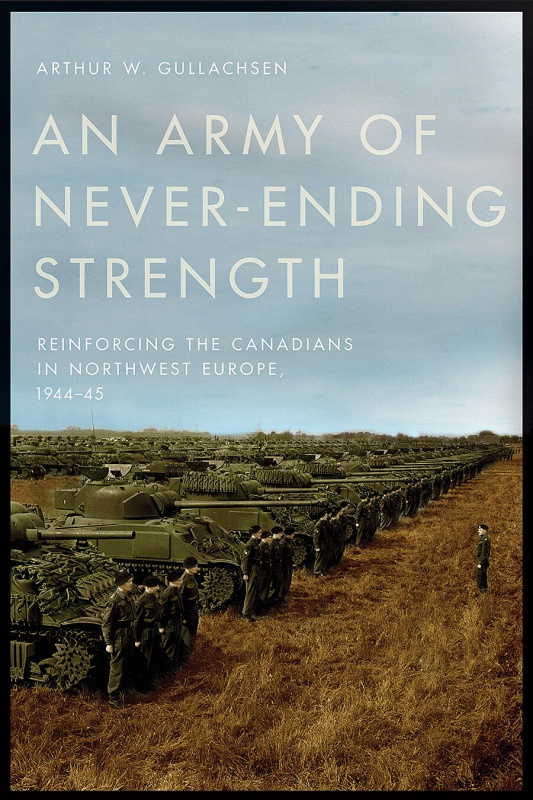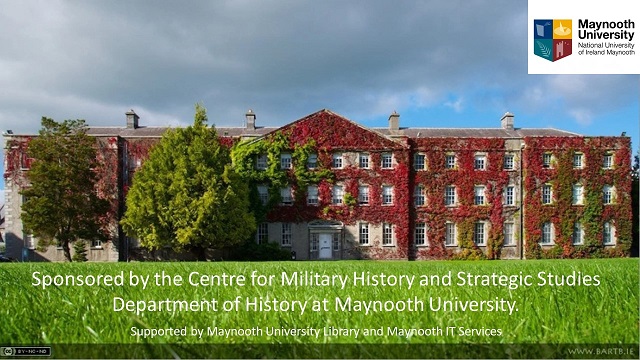Book Review: Arthur W. Gullachsen, An army of never-ending strength: reinforcing the Canadians in Northwest Europe, 1944-45, UBC Press, 2021
Arthur W. Gullachsen, An army of never-ending strength: reinforcing the Canadians in Northwest Europe, 1944-45, UBC Press, 2021, pp 254, including photographs and tables. [link to publisher]
While there is a large literature on the Canadian war effort in the First World War, there has been less scholarly attention paid to Canadian forces during the Second. The Canadian forces during the First World War had a certain level of autonomy and played a significant role in many of the major actions, particularly at Vimy Ridge in 1917 – an action that has been absorbed into the Canadian national narrative. The Canadian war effort during the Second World War was not insubstantial and by the end of the war, over 1.1 million Canadians had enlisted in the army, the Royal Canadian Navy or the Royal Canadian Airforce. Canada also emerged as an important location for training with over 130,000 Allied airmen training there while the ships of the Canadian Merchant Navy carried out over 25,000 trans-Atlantic trips as part of the huge logistics effort to supply Britain.
During the course of the war, Canadian ground forces saw a considerable amount of combat in various theatres. The early operations were less than auspicious. Deployment of Canadian forces to Hong Kong in 1941 ended in defeat and capture. In the European context, the Canadian government was keen that its troops should be used in a significant way and troops of the Second Canadian Division were assigned to the disastrous Dieppe raid in August 1942. In 1943, full Canadian divisions were deployed for the first time in Sicily and later in the Italian campaign, which was to be long and costly. This book, however, focuses on the campaigns of Canadian troops from their landing at Juno Beach in Normandy on D-Day 1944 through their subsequent campaigns to the end of the war in 1945. In the course of almost a year, the formations of First Canadian Army, commanded by General Henry Crerar, were involved in numerous significant actions including the Normandy break-out operations, the clearing of the Channel Ports and the difficult and attritional campaign in the Scheldt Estuary.
While Gullachsen gives an account of these major actions, in many ways these are not the main focus of this book. It is usually accepted that British forces, including the Canadians, were reaching a point where they had finite manpower numbers and dwindling resources overall. Gullachsen effectively argues that the Canadian forces had steamlined their training and replacement programmes in order to keep their battlefield units up to full strength. This was in contrast to other Allied formations, which struggled to supply trained replacements as the campaign in NW Europe wore on. A similar state of effectiveness was reached in terms of logistical and equipment resupply and ample data is supplied to substantiate these arguments. This is not to say that there were not shortages. This was particularly true towards the end of the Normandy campaign in August 1944 when there was a desperate need for infantry replacements. This volume makes it clear that, had the Canadian army suffered the level of casualties that had been predicted for 1945, this level of combat effectiveness may not have been maintained. There were large numbers of trained conscripts in Canada, but political opposition meant that they were not sent to Europe – the Canadian forces in theatre were all volunteers. This “conscription crisis” and the resignation of J.L. Ralston, the Canadian minister for national defence, left the replacement issue unresolved in late 1944. The incoming minister, Andrew McNaughton, made a decision to send over 16,000 conscripts to Britain in late November 1944 and over 2,400 of these would see combat. As the end of the war neared, Gullachsen shows that it was with some difficulty that a Canadian reserve force was created in order to replenish depleted units. This reserve force numbered 24,500 in April 1945 but, due to the war’s end, it remained an untapped force.
This is a fascinating book, and it is highly valuable to anyone interested in WW2 and the role of Canadian forces in that conflict. It is particularly valuable in its examination of the last year of the war – a period that is still hotly debated among military historians. It is a welcome addition to the relatively limited literature on Canadian forces during WW2. By the end of the war, over 42,000 Canadians had been killed in combat with a further 55,000 wounded. Hopefully, Gullachsen’s efforts with this book will spark a new phase of research on the Canadians in the Second World War.
David Murphy, October 2021.
Maynooth University


 This work is licensed under a
This work is licensed under a 
